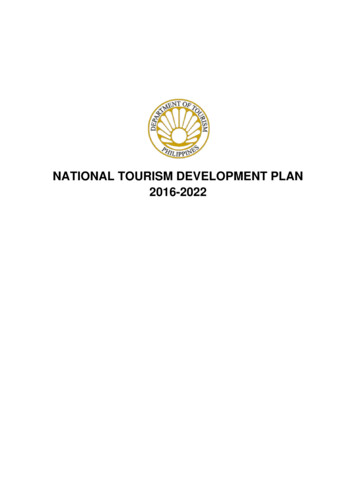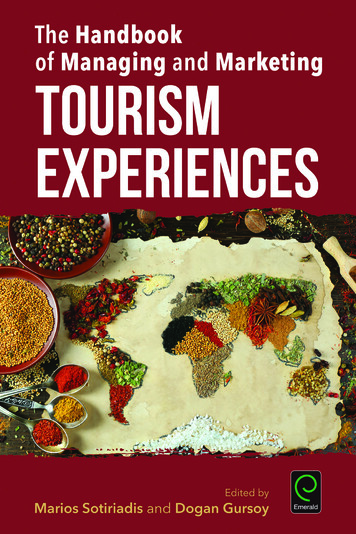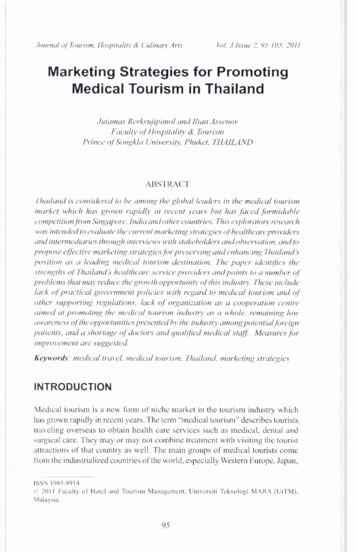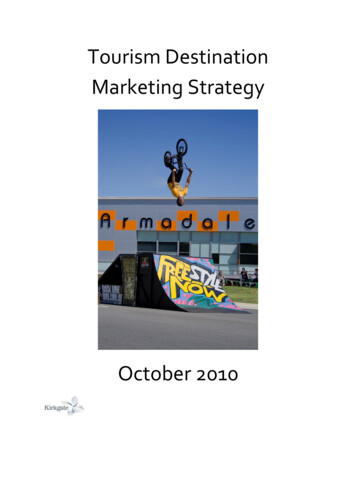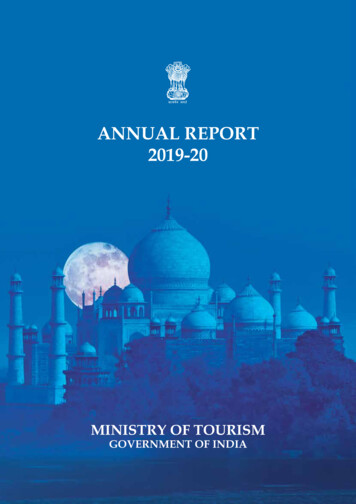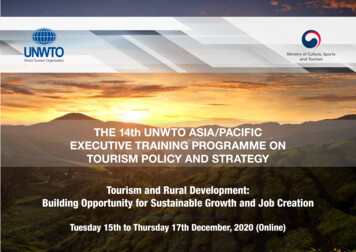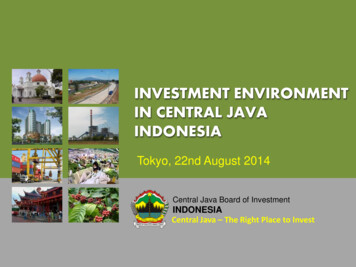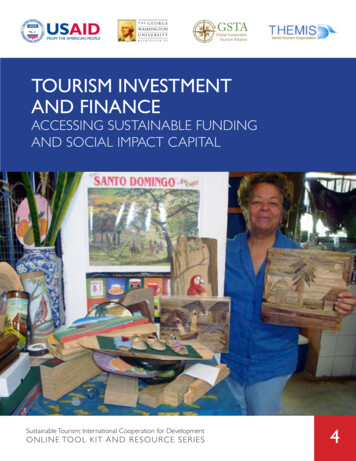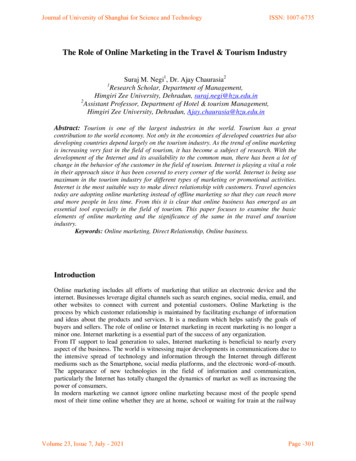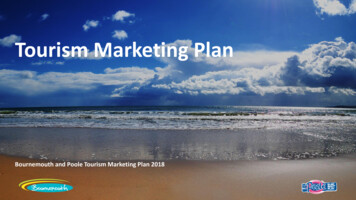
Transcription
Asia Pacific Journal of Marketing & Management Review ISSN 2319-2836Vol.2 (7), July (2013)Online available at indianresearchjournals.comONLINE TOURISM MARKETINGDR. RENU MALRAASSISTANT PROFESSOR,TOURISM, UNIVERSITY COLLEGE,KURUKSHETRA UNIVERSITY, KURUKSHETRA.Internet usage of which became a strategic element for countries becomes more and moreimportant both service industries and tourism. The reason is that internet usage increases witheach passing day and the internet provides its users with significant opportunities in terms ofpresentation. According to the data published by Internet world stats based on the researchcompany ACNielsen, 13,9 % of the 6 billion 420 million people living in the world (938 million711 thousand of them) use the internet (http://www.nexum.com.tr/ upload/yayin, June 12, 2007).Increasing internet usage of consumers expands possibilities about having product information,searching different products or brands and purchasing them. Internet is preferred by consumersor travelers because it is a tool that easy to access (%82), can save time (%80), easy to use (%59)and economical (%50) (Travi Austria, 2001). On the other hand travelers use internet forlearning flights, hotel rooms and rent a car prices (Ayers, 1999; Yeh et al., 2005). Thereforethere is increasing number of consumers or travelers who have information about their travelsby internet and use this information their travel decisions (ETC, 2006; Woolford, 2006)Social networks play an increasingly important role in the tourism sector. The dissemination ofdata, messages, opinions and images via Twitter, Facebook, blogs, Flickr and other platforms, aswell as new models of information management are now possible, are now an important part ofthe intelligence system and communication a tourist destination.The global user, is also tourist consumes and generates four or five times more information aboutour destiny as a decade ago, so that destinations have to be able to learn to "listen" and"dialogue" with the new traveler in the channels and the language in which they communicatenow, when they talk about our city or territory.Furthermore, mobile devices in communication promote tourism, which are easy to transport andaccessible. While travelers are on vacation or business trip, can use their smartphones or tabletsto find and / or share information about the destination you are.The results of the Worldwide Travel Monitor shows that 40% of international travelers travelwith smartphones with Internet access, email and other functions.These users of smartphone ,40% use them for information on the fate and 26% of visitors and 34% of business travelers usethem to change their reservations for the trip. Just over a third of international travelers use theirsmart phones to access the mobile social networks. This means that tourists, despite of theirdestination, content hanging in their Facebook pages or blogs or Twitter or Flickr photographs.The information processing management at tourist destination, now has new strategies thatleverage and segment the common information about the destination, before making decisionsunder the Tourism Cluster model. The new information processing through the prism of SmartDestination or destination smart, its make the most of online social tools to feed both the150
Asia Pacific Journal of Marketing & Management Review ISSN 2319-2836Vol.2 (7), July (2013)Online available at indianresearchjournals.comintelligence of fate, as the interactions agents and tourist destination, can generate through socialnetworks .The general objectives of internet marketing are described as: Online activities can enhance and boost up offline effort in brand development. Revenue generation. Online channels do not only save advertising or promoting cost, butthey also increase revenue for businesses through generating sales and supporting directmarketing campaign. Customer service/support. With online marketing, company has more channels tocommunicate with customers, understand customers‟ interest and the product or servicedevelopment strategy can be done more correct. (Charlesworth 2009, 28.)There is a transformation about internet usage from using it as an information source to a mediaor channel that can be used for shopping. Although it is important to use internet as aninformation source, but it is also important to sell products and services for travel and tourismmarketing area (Walle, 1996). The nature of travel and tourism industry is required efficiency incommunication and message transformation (Seaton and Bennett, 1996). In this sense manydestination management organizations and tourism companies try to increase communicationalopportunities through internet and websites (Legoherel et al., 2000). According to Ekiz et al.‟s(2005: 7) literature analyzing about internet usage there is benefits and drawbacks of internet as amarketing communication tool as can be seen in Table 1.Table 1. The benefits and drawbacks of internet marketingBenefits Accessing to greater number ofcustomers Exposing the property Advertising and promoting Communicating better Providing online reservation Identifying and targeting customerseasily Being a source of information Saving costs and time Being free from boarders Being inexpensive Being flexible and convenient Globalizing products and services Increasing customer interaction Allowing one-two-one marketing Being accessible 24 hours and 365 daysDrawbacks- Costs involved in constructing, maintaining andupdating- Security, privacy, and confidentiality- Cultural differences- Training, lack of knowledge, ignorance- High competition- Loss of personal touch- Alienation of the potential customers- Telecommunication infrastructureSource: Ekiz et al. (2005: 7).151
Asia Pacific Journal of Marketing & Management Review ISSN 2319-2836Vol.2 (7), July (2013)Online available at indianresearchjournals.comWEB MARKETINGElectronic (E)-Business involves both Internet Marketing and Electronic (E)-Commerce. Internetmarketing deals with promoting and driving traffic to a Web site through Web Marketing (PullStrategy) and E-mail Marketing (Push Strategy) whereas E-Commerce focus on selling productsand services on a Web site.The backbone principles of Web Marketing are: Giving customers a reason to come to the Web site, by the means of promoting the website both online and offline to first time and repeat visitors, providing a compellingcontent that will make someone want to return, and giving free information, i.e., attractvisitors to the site by giving away free information, and then try to sell products andservices to those who visit the site. For a DMO this involves giving information such ason useful facts, photos and videos of the destination, how to get to the destination, andwhat internal transportation means are available in the destination, providing a routeplanner, places to stay and things to do at the destination as well as booking facilities. Building Trust, by selling well-known brand name products and services, by offeringguarantees, by providing a customer-friendly navigation system and intuitive interface, aSSL secure server for credit card transactions, and by repeat contact with the web sitevisitors. For instance, a DMO should stimulate a visitor to sign a guest book and help himto create his personal brochure to build his own guidebook to the destination. This opensthe opportunity to the DMO to collect visitor information like name, area of residence,email address, age and gender, source of information to visit the site, reason to visit thesite, intention to visit the destination. Pull and Push Strategy, i.e., pull customers to the web site by its attractive content, thenpush quality information to them regularly via e-mail. For example, the informationcollected by a DMO from its web visitors can be analyzed to come up with customerprofiles that may then be used to email visitors with the travel-related information mostlikely to be valued by them. DMOs ought to develop their own web sites for destinationmarketing in order to accomplish a number of purposes:o Brand Development, i.e., present the destination in the best possible light. Seekingto communicate an image about the destination that will register in the minds ofthe visitors (existing tourists and prospects) in order to achieve repeat business.o Revenue Generation, which considers three sources of income from thedestination‟s online business. First, in the prospect generation model the DMOuses the Web to bring the destination leads and provide information [ 17, 181 tosupport the sale, which is closed either by phone or e-mail. A main tool is acarefully designed online response form. E-mail links allow visitors to contact theDMO, but the online form allows structuring the information, so the DMO canqualify the prospect and know how to respond. Nowadays, is already possible toautomate the delivery of customized information, provide quotes via databasequeries and then consummate the sale online. The second model consists incompleting the actual sales transaction over the Internet, which is often referred to152
Asia Pacific Journal of Marketing & Management Review ISSN 2319-2836Vol.2 (7), July (2013)Online available at indianresearchjournals.comas “e-commerce”. The third is the referral generation model. Customer acquisitioncosts from an affiliate program have been found to be substantially less thanpaying for banner ads with CPM prices. Cost Savings, i.e., achieve maximal cost savings on the Internet. The Internet can savecosts to a DMO in various ways: (1) Staffing - it is significantly less expensive and moreaccurate to have a visitor enter an order over the Internet than it is to take it by phone orre-key it into the computer system after the sale; online transactions dramatically cut thecost of processing a purchase order. (2) Distribution of sales materials - the web is a wayto distribute great amounts of information inexpensively, and the updating of data ismuch simpler, too. A DMO can save a lot of money on printed literature (e.g. brochures)by having these translated and adapted to the web framework and motivating tourists tolook for that sort of information on its web site. (3)Advertising costs are low since searchengines do much of the work. However, to drive a high number of visitors to the DMO‟sweb site, a combination of paid online and offline advertising should be considered. Customer Support. Providing excellent online customer the means of a , support, forinstance through FAQ (Frequent Asked Questions). From a managerial perspective, theWorld Wide Web (WWW) is a powerful tool for assisting DMOs to perform their threemajor functions: (1) information provision; (2) marketing and promotion activities; and(3) market research. From a technical viewpoint, the development of a Web site for aDMO entails three major tasks, as shown in figure1 : (1) Web Design; (2) Web sitePromotion; and (3) Web site Performance Measurement.TOOLS OF INTERNET MARKETINGWithin our world nowadays, Internet plays a vital role to the society. This part gives a briefintroduction of different tools of Internet. Furthermore, it also introduces main types of Internetmarketing used in business today.WebsiteWebsite is for sure the most common thing when discussing about Internet and Internetmarketing. Some parts of website and website management that are essential to marketers andbrand makers are: domain names, website design and management and the real important mattersin website management in marketers‟ point of view.„Every essence on the Internet is identified by a series of numbers – called the Internet Protocol,or IP, address‟ (Charlesworth 2009, 37). The primary of a domain name is the suffix. When aname is registered, it will take the suffix of the registered naming authority. The most popularsuffix is dot com, or .com. When indicating their use as the URL (Uniform Resource Locator), ithad become accepted to use the prefix „www‟ on the primary domain name. The case of second,third, fourth and more level domain basically is because there are so many names are alreadyregistered, so to prevent the identical domain name, there is a need for second, third or fourthlevel domain. Moreover, domain names needs to be at least three and less than sixty threecharacters (Charlesworth 2009, 38).In website design and management, simplicity is the key. If a website is full of text and hard toaccess, visitors do not find creativity, or easiness, to approach information and interest, they will153
Asia Pacific Journal of Marketing & Management Review ISSN 2319-2836Vol.2 (7), July (2013)Online available at indianresearchjournals.comnot come again. Usages of website are to generate return on investment (ROI), branddevelopment and support online sales and marketing. Hence, it is vital to take care of websitedevelopment. Today, flash technology is well-known in website designing. It is used a powerfultool to make the websites become more user-friendly, easy to access and surf. (Charlesworth2009, 81 – 88.)Besides, key issues in designing a website are: download time, make things easy on the eye, fontsize, page width, subject of page width, respect the conventions of the web, avoid non –standard, ensure the design features of the site are appropriate to its objectives, be aware of usingimages on website and grammar and spelling. (Charlesworth 2009, 81 – 88.)Search enginesSearch engines, for example Google, Bing, Yahoo, etc., are used by millions of users every dayto look for information they need. Search engine operates by providing services (searching,matching results, showing relevant results, etc) to users and leading users to a website ormultiple websites relevant to their search. The search engine works by assessing websites forsuitability in matching the search and presenting the results of its assessment. When searching ona search engine, the result page will show two types of results: organic result and paid result.Organic result, or natural result, is free results chosen by search engines by relevance, visitors‟statistics, trusty level of the website, etc., while paid result is sponsored links and is paid bycompanies to promote their product. Both organic and paid results are presented on the sameresult page and relied on keywords selection. Paid result, however, appears on top, or on one sideof the search engine result page to get users‟ attraction (Charlesworth 2009, 181).Companies see search engine as a chance to promote their product or service to wide-rangeusers. As a result, the definition of search engine optimization and keyword bidding were born.Search was the largest single advertising revenue generator on the Web. It accounted for 47% ofall online advertising revenue, as opposed to 22% for online display advertising and 10% ofclassified ads. And also, over 90% of people use search to launch websites, whether they knowthe URL address or not (Sheehan 2010, 34).Keyword selection is vital in search engine optimization (SEO) as well as search marketing.Keyword is the bridge to connect searchers with the businesses that have services that searchersare looking for. In order to get higher ranking on searching result service pages, websitedevelopers should figure out and then concentrate on the right keywords. It is claimed thatEnglish gives no big help in SEO because the search localization is more developed now, solocal people tend to use their mother tongue for search. In some cases, foreigners use locallanguage to search, especially for destinations‟ names, such as: Munich/Muchen. Also, somelanguages have similarities, consequently, people have the tendency to search based on whatthey are mostly used to and not to use English in search. (Charlesworth 2009, 181.)Search MarketingAs mentioned above, results from search engine result pages are shown with organic results andpaid results; thus, search marketing can be made on both of them. First of all, for organic results,or natural results, the process of search engine optimization (SEO) is vital. Because organicresults are free links, there is a harsh competition to gain your site‟s appearance on the search154
Asia Pacific Journal of Marketing & Management Review ISSN 2319-2836Vol.2 (7), July (2013)Online available at indianresearchjournals.comengines. SEO includes: choosing the right keywords and phrases that are potential, unique yetnecessary; focus specific keywords for specific parts of the page; name your website withrelevance and submit your sites to as many directories as possible to gain the ability to get intoyour site (Sheehan 2010, 37). On the other hand, for paid results, it is certainly that your link willappear on top of the search engine result page. Paid search has been one of the most growthsections among online advertising types.For branding destination, search is a filter that gives analysts a better knowing about customers‟trend and interest which will lead the business to the right direction. Naturally, places that paymore attention on building a strong base of service websites would conduct a strong brand.Consequently, they have more advantages than other destinations. (Pritchard et al. 2004, 128.)Social networksNot long before, people were not so aware of what social media is and how it appears to be a partof our lives. Years have passed since the development of Web 2.0, the pre-stage of tremendousadvance of social media and social networks, but the implementation of social media inmarketing and branding is popular just few years recently. Some common kinds of tourismdevelopment tools implemented by social media are: blog, vlog, public videos, social forums andsocial networks (Sheehan 2010, 10).Sheehan (2010) claims that social media marketing is competitive because, first of all, they savetime and cost. Second of all, they change the way consumers hear and learn about and decideabout the products and services, which shows the synergy of social media with viral marketing.Customer relationship is tightened through social networks. Lastly, it contains the ability togather larger groups of people to have idea about the services and the brand and get them to givesuggestions to develop (Sheehan 2010, 100 - 106).The important feature of social media is that everything is a two-way communications(Charlesworth 2009, 301). Also, the reason why social media marketing is more favorednowadays is that people are fed up with brochures, posters, billboards and advertising becausethey do not provide trusted and helpful necessary information. Social travel forums offer handy,useful and updated tips, experience and information on the destinations. (Social media onDestination Branding 2010.)Social media marketingThe cooperation of social media and traditional way of doing marketing and advertising cancreate a much bigger influence from viewers, tourists and travelers. It is mentioned that eventhough the use of social media in tourism branding is increasing now, it is necessary not to forgetthe destination‟s slogan and marketing message. In short, the application of social mediaenhances tourism strategy in many aspects, plus, it is wise to make use of the advantages ofsocial media in the brand marketing strategy in order to spread out the brand‟s image, messageand information. (Social media on Destination Branding 2010.)155
Asia Pacific Journal of Marketing & Management Review ISSN 2319-2836Vol.2 (7), July (2013)Online available at indianresearchjournals.comE-mail marketingE-mail marketing is a basic marketing form when mentioning about Internet marketing. Almostany Internet user is familiar with this type of advertising because, everyday, uncountable numberof e-mails is sent to end-customers, to potential partners, to communicate with customers, etc.with different meanings, purposes and all in order to update information for customers. Using email for business improvement, expansion and updating is not new, yet it is still a supportive anefficient tool in marketing. In total, e-mail marketing can be divided into two categories lies onits aim: E-mail as a medium for direct marketing and E-mail as a medium for marketingmessage. (Charlesworth 2009, 255).E-mail direct marketing represents by email subscription, announcement e-mail sending after aperiod of time and all. However, in order to avoid spam and junk e-mails, also confuse thecustomers and decrease the business‟s image, development the „email campaigns that request thepermission of the consumer‟ (Sheehan 2010, 84) is a wise choice. This campaign needs theunderstanding of two ways of getting the customer‟s permission which are: opt-in and opt-out.Opt-in and op-out help marketing executives receive more precise email address database, targetgroups and customers‟ interest. „Opt-in is where the receiver chooses to receive email by takingaction‟ (Charlesworth 2009, 258), or it is „where the consumer requests to continue receiving thee-mailings‟ (Sheehan 2010, 84). While on the other hand, „opt-out is where the receiver musttake an action to opt-out of receiving e-mail messages‟ (Charlesworth 2009, 258), or „where theconsumer does not opt-in then they will receive nothing more‟ (Sheehan 2010, 84).E-mail marketing is used widely in tourism industry with the purpose of giving both direct andmarketing message. E-mail marketing is chosen because it is fast, time-saving, cost effective andwide spread. By carrying out e-mail marketing campaign, together with offline advertising tobring out the better enhancement, tourism business is active, moving and updated all the time,and finally directs to the change, the development, the improvement of destination brandingstrategy. (Charlesworth 2009, 256.).Web marketing is the tool to build the image of any tourism destination. This is the way withwhich one can access a wide geographical area. Its various techniques like email marketing,social media marketing, website, and search engine marketing helps in developing and cateringthe wide area 1 babacan and 04 46637/Duong Linh.pdf?sequence 1Ayers, L. (1999). Do you use internet travel services, Opinion, 1(April), 24-33.156
Asia Pacific Journal of Marketing & Management Review ISSN 2319-2836Vol.2 (7), July (2013)Online available at indianresearchjournals.comBurger, F., Karoib, P., Pröll, B., Richtsfeld, R., Sighart, H. and Starck, H. (1997). TIS@WEB databasesupported tourist information on the web. In A.M. Tjoa (Eds.) Information and CommunicationTechnologies in Tourism, (pp.180-189). Wien: Springer-Werlag.Doren, D. C., Van, F., Deborah L. and Green-Adelsberger, K. (2000). Promotional strategies onthe worldwide web, Journal of Marketing Communications, 6(1), 21-53Ekiz, H. E., Guneren, E. and Ozturen, A. (2005). KKTC konaklama endustrisinde internetpazarlamasi: arzve talep boyutlari, PI: Pazarlama ve Iletisim Kulturu Dergisi, 4(12), 4-14.Esrock, S. L. and Leichty, G. B. (2000). Organization of corporate web pages: publics andfunctions, PublicRelations Review, 26(3), 327-344European Travel Commission-ETC (2006). Online travel market, [Online] retrieved 10 June2006 SectionID 10.Gibson, R., Margolis M., Resnick D. and Ward S. (2001). Election campaigning on the www inthe US and UK: a comparative analysis, American Political Science Association, [Online]retrieved 15 June 2006 from output.html.Ihator, A.S. (2001). Communication style in the information age, Corporate Communications:AnInternational Journal, 6(4), 199-204Jo, S. and Jung, J. (2005). A cross cultural study of the world wide web and public relations,CorporateCommunications: An International Journal, 10(1), 24-40.157
opportunities through internet and websites (Legoherel et al., 2000). According to Ekiz et al.‟s (2005: 7) literature analyzing about internet usage there is benefits and drawbacks of internet as a marketing communication tool as can be seen in Table 1. Table 1. The benefits and drawbacks of internet marketing Benefits Drawbacks
